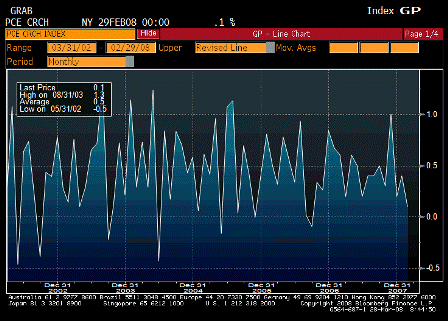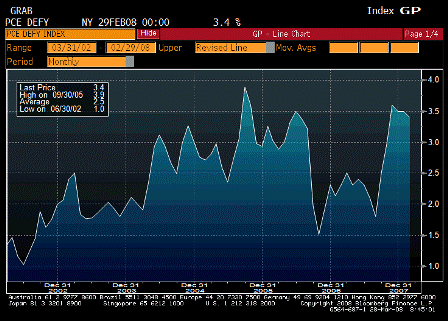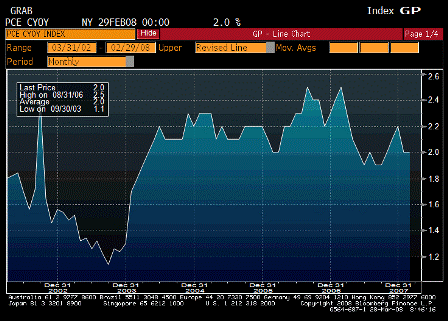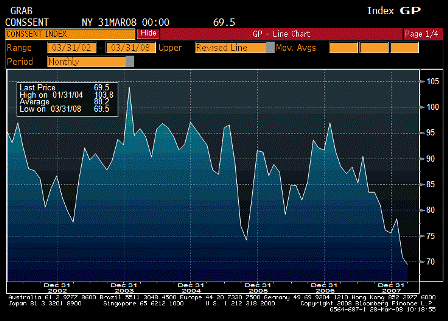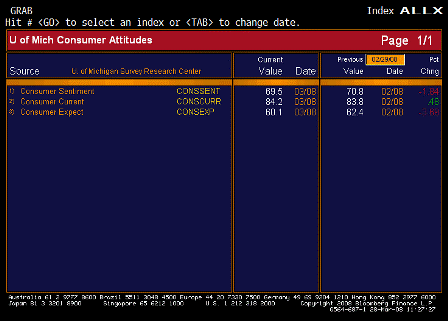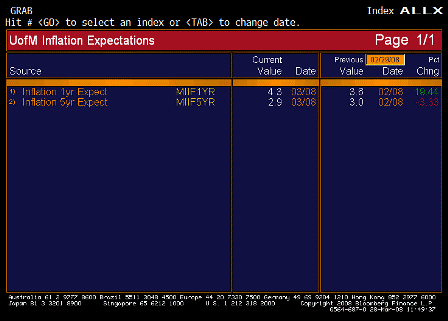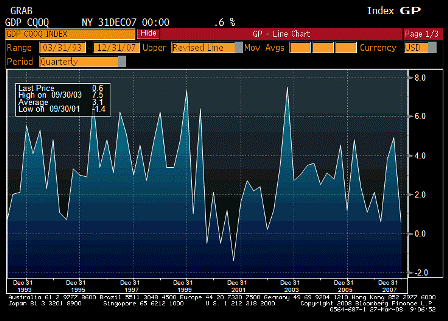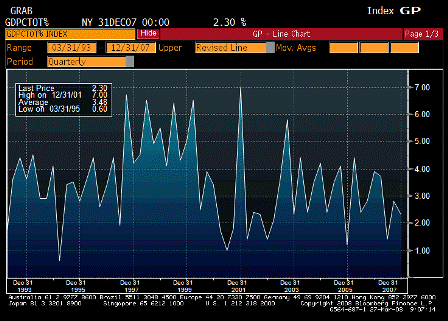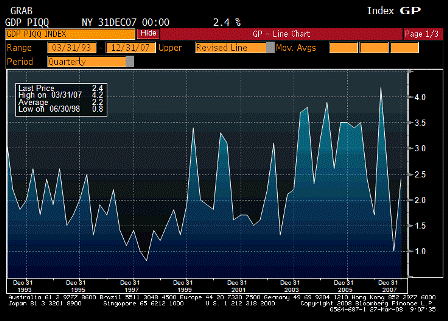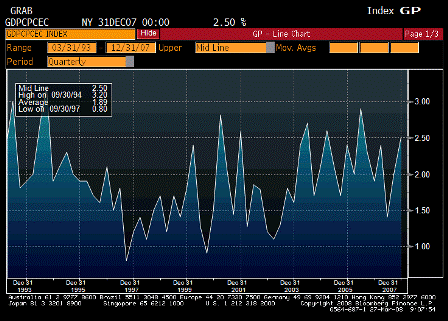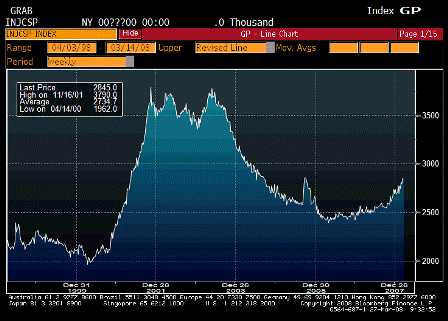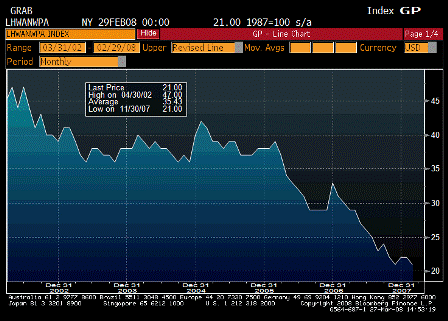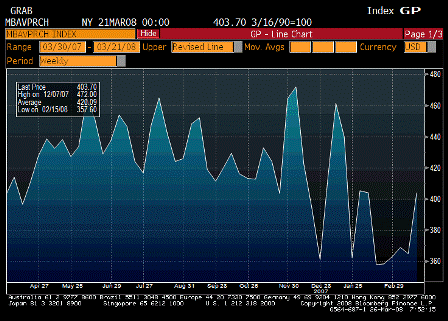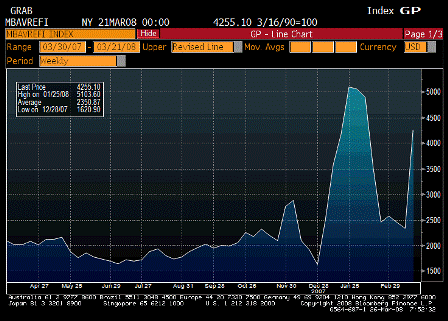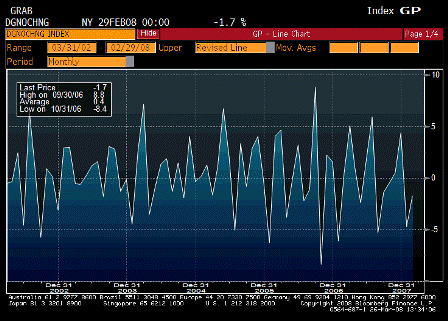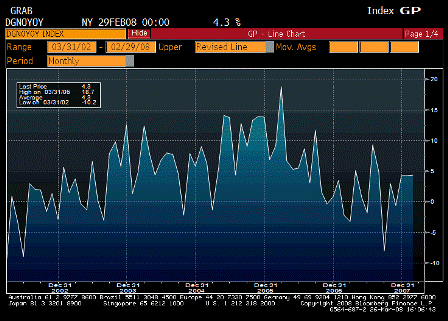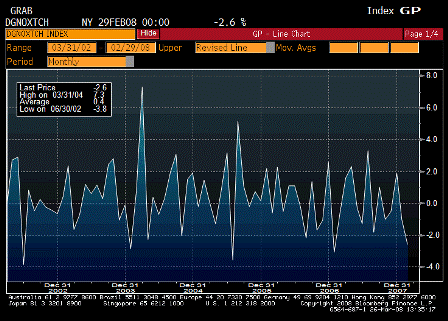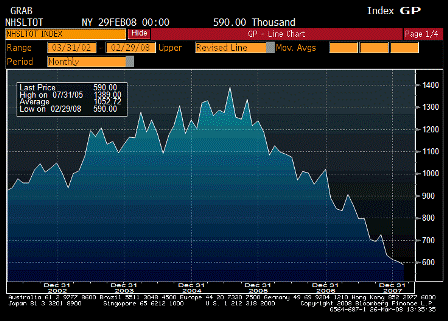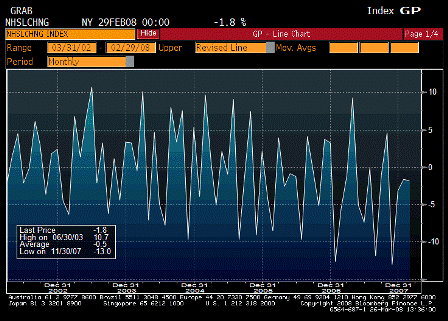Japan data volatile as usual, but a few interesting bits that are worth a quick look:
Industrial Output Falls 1.2% In Feb
(Dow Jones) Japanese industrial output declined in February, partly due to weaker overseas demand for electronic parts and devices, increasing worries that a downturn exports will slow the economy.
Separate data, meanwhile, showed that Japanese workers’ salaries rose for the second consecutive month. But the rise was mostly canceled out by higher consumer prices, so the higher wages are unlikely to give the broader economy much support.
Higher nominal wages probably represents elevated ‘inflation expectations’ to their mainstream economists.
Industrial output fell 1.2% from the previous month after adjustment for seasonal factors, according to data released Monday by the Ministry of Economy, Trade and Industry.
But better than expected:
The result was better than the 2.2% decline expected by economists surveyed by Dow Jones and Nikkei. The ministry said manufacturers expect their output to rise 2.0% in March, and to decline 1.0% in April.
Lower domestic production for pulp, paper and paper products, which was off 2.7% on month, also pushed overall output down.
Production issues?
Wages up for 2nd straight month
Meanwhile, Japanese workers’ average cash earnings rose for the second straight month in February, growing 1.3% on year to Y274,521, preliminary data from the Labor Ministry showed Monday.
Behind the rise was a 2.4% on-year increase in the number of full-time employees, the government said.
The rise in salaries and full-time employees “reflects businesses’ increasing efforts to secure against mid- to long-term labor shortages” and this could continue for a while, Yamamoto said.
Labor shortages and rising wages? That’s a change from the last fifteen years.
In January, wages climbed a revised 1.6% on year, following a 1.7% fall in December.
Still, “amid current price rises, it may take some time until salary rises help push up private consumption,” Yamamoto said.
Last Friday the government released data showing that the nationwide core consumer price index rose 1.0% on year, the biggest increase in almost a decade.
Average monthly wages excluding special allowances rose 0.9% on year to Y250,347, and average overtime pay also increased 2.6% to Y20,095. Special allowances jumped 28.1% to Y4,079.
Feb Construction Orders Up 18.4% On Year
Maybe they got the permit thing sort of straightened out? If so, most likely a large backlog to start working off.
(Dow Jones) Total construction orders received by Japan’s 50 leading domestic contractors rose 18.4% on year to Y1.221 trillion in February, the Ministry of Land, Infrastructure and Transport said Monday.
Orders fell 5.7% in January and rose 4.7% in December.
Orders from the public sector rose 45.9% to Y337.1 billion. Meanwhile, private sector orders gained 8.9% to Y776.8 billion.
Overseas construction orders rose 51.1% to Y59.1 billion, the ministry said.
Feb Housing Starts Fall 5.0% On Year
(Dow Jones) Japan’s housing starts fell 5.0% in February from a year earlier to 82,962 units, the Ministry of Land, Infrastructure and Transport said Monday.
The decline was larger than the 1.0% drop forecast by a Dow Jones/Nikkei poll of economists.
That was the eighth consecutive month of falls after orders dropped 5.7% in January and 19.2% in December.
Annualized housing starts stood at 1.15 million units.
That’s more than the US with maybe half the population.
Housing starts for individual homes in January fell 2.1% on year to 22,494 units, while rental housing fell 3.1% to 33,063 units.
Multiunit dwellings, meanwhile, declined 9.7% to 26,757 units, including condominiums.
And the drop is part of the permit problem?
The results suggest the fallout from a legal change that created bottlenecks for housing permits is gradually easing. Economists said, however, that a sudden recovery remains unlikely with corporate and household sentiment at multiyear lows.
Oil Imports Rise 8.2% In Feb, Up For 5th Straight Month
Demand remains high at current prices?
(Kyodo) Japan’s crude oil imports in February rose 8.2 percent from a year before to 127.18 million barrels, marking the fifth straight month of expansion, the Natural Resources and Energy Agency said Monday.
Imports from the Middle East accounted for 86.7 percent of the total, down 1.4 percentage points from a year before, the agency, under the Ministry of Economy, Trade and Industry, said in a preliminary report.
By country, Saudi Arabia remained the biggest supplier to Japan, exporting 35.98 million barrels, up 4.2 percent.
The United Arab Emirates stayed second with shipments rising 3.9 percent to 32.65 million barrels.
Iran was in third, exporting 16.48 million barrels, up 28.6 percent, followed by Qatar’s 9.56 million barrels, up 5.3 percent, and Kuwait’s 9.44 million barrels, up 5.7 percent.
Domestic output of petroleum products such as gasoline, naphtha and jet fuel in February rose 5.8 percent to 18.32 million kiloliters for the fifth straight month of increase. One kl equals 6.29 barrels.
Sales of such products in Japan increased 4.2 percent to 20.12 million kl, the second straight month of growth, the agency said.
Number Of Full-Time Workers Posts Highest Rise In 16 Years
(Kyodo) The number of full-time workers at firms with at least five employees in Japan rose 2.4 percent in February from a year earlier to 33.02 million, marking the highest pace of expansion in almost 16 years, the government said Monday.
The number of such workers, including permanent and nonpermanent jobholders, increased by more than 700,000 from a year before, the Ministry of Health, Labor and Welfare said in a preliminary report.
”Many companies are increasingly converting part-time workers to full-time workers, which may be behind” the highest pace of increase since June 1992, a ministry official said.
In contrast, the number of part-time workers at such firms increased by a mere 0.9 percent in February, with the pace of increase being smaller than that of full-time workers for the first time in 16 months, the report said.
The increase in full-time workers is attributable partly to the revised part-time labor law to be implemented Tuesday, which requires firms to take measures to promote shifting of part-timers into full-time employees on the regular payroll, analysts said.
Many companies have already been taking such steps ahead of the implementation of the law, they said.
Also, some big firms have been accelerating efforts to convert part-time and temporary workers into full-time workers amid the continuing expansion of the Japanese economy.
Such development is in contrast with the employment policy of large companies after the bursting of the nation’s asset-inflated economy in the early 1990s, in which they had to trim the number of full-time regular workers and increase the number of part-time workers in order to cut personnel costs.
Large companies including Takashimaya Co., Toyota Motor Corp. and Sumitomo Mitsui Banking Corp. have been increasing the number of full-time workers in a shift from past policy.
The ministry also said in the same report that average winter bonuses at the end of 2007 per regular employee at firms with at least five employees fell 2.8 percent from a year earlier to 417,507 yen for the first decline in four years.
The decline was partly attributable to lingering uncertainty over the Japanese economic outlook, the ministry official said.
Temporary Fall In Road Tax Not Seen Harming Economy
(Nikkei) If the rates on the gasoline and other road-related taxes are lowered from April, Japan’s economic growth may suffer, but the impact would be limited if lower rates are in place for only a few months, according to an estimate by Nikkei Digital Media Inc.
However, reduced taxes for a full year could cause economic growth to decline by up to 0.3 percentage point due to a cutback in road construction.
The firm’s Nikkei Economic Electronic Databank System (NEEDS) service projects that if road-related taxes become lighter, tax revenues for the central and local governments would shrink by a total of 2.6 trillion yen, while disposable income at households would increase by 1.6 trillion yen and corporate revenue would jump by 1 trillion yen. Other factors expected to affect actual economic growth include a reduction in public spending on road construction.
The tax rates are set to fall as a result of political deadlock over a bill to extend the provisional surcharge imposed on gasoline and other items.
The government and ruling parties aim to bring the lowered rates back to the current levels when the ruling coalition-controlled lower house gains the right to vote for the move in late April. If the higher rates are reimposed from the July-September quarter, and a 2.6 trillion yen reduction in public works spending is averted, fiscal 2008 economic growth would expand by 0.1 point. Under such a scenario, the impact from the tax rate change would be limited, with consumer spending estimated to grow by 0.1 point thanks to lowered gasoline prices, among other factors, and corporate capital investment is seen increasing by 0.2 point.
If the road-related taxes remain lower throughout fiscal 2008 and public works spending remains intact, financed by increased issuance of government bonds, economic growth would be boosted by 0.2 point, with consumption and corporate capital spending estimated to grow by 0.3 point and 0.4 point, respectively.
On the other hand, if the tax rates stay lower for the entire year and public spending is reduced, that would likely have a negative impact on economic growth. A 2.6 trillion yen reduction in public investment would hamper GDP growth by 0.3 point, and a 1.3 trillion yen cutback would push growth down by 0.1 point, with the positive effects of increases in consumer spending and corporate capital investment expected to be more than offset by a decrease in public works spending.


